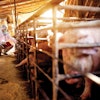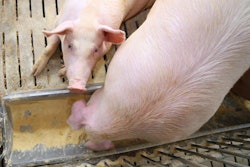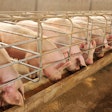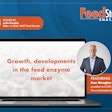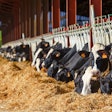
Global supply chain bottlenecks have resulted in high raw material and feed additive costs, which will continue to affect feed industry profitability into the new year.
At the height of the COVID-19 pandemic, all industries worldwide experienced the effects of extremely challenged supply chains.
“Several ripple effects were felt throughout the agriculture industry, causing massive domestic and international supply chain disruptions — the stockpiling of goods, including of animal food, shortages of essential feed ingredients, and reductions in workforce, to name a few,” said Constance Cullman, president and CEO of the American Feed Industry Association (AFIA).
Now, nearly two years later, global supply chains continue to struggle and are “arguably in the most dire condition since the start of the pandemic,” said Dan Kowalski, vice president of CoBank’s Knowledge Center in its Q4 2021 quarterly report.
High vaccination rates, a steady economic recovery and insatiable consumer demand have not tempered COVID’s market effects — and, in some ways, have heightened it — as supply chain disruptions and labor shortages persist.
Heading into 2022, how will supply chain bottlenecks and related rising raw materials costs affect nutritionists and feed producers?
COVID fallout continues to challenge ports
Around the world, countries are grappling with transportation and logistical issues rooted in a pandemic-fueled spike in ecommerce, facility shutdowns and the bevy of variables fueling the inability to find skilled (and willing) labor.
Port congestion and high freight rates, i.e. the price of a container has more than tripled since last year, have caused delays and lost profits.
Shipping container usage was up 20% in August 2021, but with a 20% longer turnaround time — utilizing more containers without shipping more cargo, Reuters reported.
At U.S. ports, the backlog is attributed to a longshoreman shortage, backing up cargo ships anchored off shore and leaving shipping containers full of imported goods to sit. This has also resulted in empty containers being returned to Asia “without being loaded with U.S. agricultural commodity exports, as well as the imposition of millions of dollars worth of punitive charges,” Cullman added.
“Our industry has also felt the impact on the ability to import products due to extreme port congestion,” she said. “The issues at the ports are not only causing a financial burden to our members, but it is making it more difficult for them to fulfill international and domestic customers’ orders in a timely way. With more than 20% of agricultural production exported abroad, it is critical that our country work expeditiously to resolve these issues on behalf of U.S. manufacturers.”
In mid-October, U.S. President Joe Biden announced plans to keep California’s Ports of Los Angeles and Long Beach, which serve as the port of entry for 40% of the nation’s shipping containers, open 24 hours a day, 7 days a week until the backlog is cleared. The White House has also partnered with large importing companies, including Walmart, UPS and FedEx, to expand their hours to move cargo off the docks to allow more ships to unload.
COVID-19 caused the closure of two of China’s busiest ports in 2021, further causing “congestion and delays on global shipping routes.”
Labor shortage hits agriculture
The supply chain transportation crisis isn’t limited to the ports. Railroads have restricted shipping to deal with container backlogs in their rail yards. Countries don’t have enough truck drivers to transport product or workers to perform the critical tasks to support food production.
“The coronavirus pandemic has impacted every stage of our food supply chain, from commodity production through processing and delivery,” U.S. Secretary of Agriculture Tom Vilsack said in an October statement when announcing $500 million in targeted assistance to provide relief from agricultural market disruption, such as transportation challenges and the availability of certain materials.
In the United Kingdom, Brexit has largely resulted in a shortage of up to 100,000 heavy goods vehicle (HGV) drivers, the Road Haulage Association (RHA) reports. Agribusiness is challenged to not only haul raw materials and finished products, but for retailers and foodservice industries to receive refrigerated goods, such as meat, eggs and dairy products, leaving grocery store shelves empty and restaurants altering their menus.
Europe is estimated to face a shortage of 400,000 truckers.
“It’s something we didn’t even fathom two years ago. It’s completely surprising how quickly very basic things can be disrupted,” said Nicholas Guthier, Evonik’s vice president of Europe and global accounts – animal nutrition.
Animal agriculture has long struggled with labor shortages; however, the pandemic has exacerbated them, Cullman noted: “The animal food industry is struggling to fill open positions in manufacturing facilities with skilled workers.”
Meanwhile, farmers don’t have enough hands to harvest crops and meat packers struggle to find and train employees to man the processing lines.
 Governments are working to solve the global supply chain crisis. (ismagilov | iStock.com)
Governments are working to solve the global supply chain crisis. (ismagilov | iStock.com)Spike in raw materials, additive prices
Supply chain disruptions are responsible for a steep increase in the price of raw materials and feed additives, decreasing feed industry profitability.
“Since autumn of 2020, global grain prices have rallied to 10-year high levels, fueled by the economic recovery and record low ending stocks, e.g. a seven-year low in global stocks. There are few signs for a weakening of the current farm market trend until spring 2022,” European Compound Feed Manufacturers’ Federation (FEFAC) President Asbjørn Børsting reported.
Grain prices have stabilized since summer highs. However, all eyes are focused the outcome of the 2021-22 harvest and 2022 planting activity in the leading grain-producing nations.
If disruptions in global grain markets continue, nutritionists may lean toward sourcing more local raw materials, leading to a higher diversity in the ingredients being used.
“If you have to frequently change and adapt your formulations for your animals, it calls for better analytical intelligence and a solid raw material analysis scheme,” Guthier noted.
With feed accounting for up to 75% of the cost of animal production, high prices may prompt producers to alter formulations in ways that could impact feed quality and animal productivity.
“A case in point would be the use of fewer mold inhibitors or acidifiers due to price pressures,” said Dr. Bernhard Eckel, vice president – product development and technical sales, Dr. Eckel Animal Nutrition GmbH & Co. KG. “Here, we can clearly see that the use of certain feed additives that affect performance can actually be more profitable than doing without them under the current conditions. For example, we can save on feed [costs] if the same amount of animal protein can be produced with less feed.”
To mitigate supply risks, feed producers and feed industry suppliers are booking contracts earlier with more reliable suppliers and paying a premium.
“Many customers book quarter by quarter, at least with the micro ingredients. They now look at longer cycles, where having the best price is less important than having secured the material,” Guthier said. “We see shifts in the mindset. Very price-oriented buyers have moved toward becoming more security-oriented buyers. Companies are willing to pay more for reliability rather than having a low-price contract with a supplier who in the end can’t deliver.”
Who will pay the price?
Some suggest supply chains will stabilize by mid-2020. Rising costs, which until recently have been partially buffered by businesses, will soon be passed to the end consumer.
“In the months to come, we will be passing through a remarkable inflationary period,” said Oriol Roige, technical manager, Bioiberica Animal Nutrition.
According to CoBank, the August 2021 producer price index (PPI) was up 20% year-over-year, but the consumer price index has increased by 5.2%, meaning companies have absorbed most of the price increases. However, near the end of the 2021 and in to 2022, consumers are expected to see high costs as businesses move to offset these losses.
Inflation is being described as a temporary or “transitory” symptom of the pandemic’s aftermath — at least by those with an interest in placating the public — and will eventually stabilize in 2022, but could also result in “elevated underlying inflation” long term.
“I have a sense that you’re going to see more consolidation — and ultimately, that’s not a good thing for the end consumer,” said Dave Taylor, area business manager – feed – Americas, Borregaard. “The consumer has a lot less flexibility in who they use and some of the price exploration or the need to innovate goes away. As supply and demand comes into equilibrium, I’m concerned that the consumer will be hurt by the lack of optionality.”
Challenges aside, sources suggest the feed industry is generally optimistic about 2022, acknowledging risks, but also having learned to quickly pivot, remain flexible and prepared to rely on mitigation strategies when expecting the unexpected.
References available upon request.
Top 2022 U.S. animal feed industry issues to watch: https://bit.ly/3vtfJw0
4 feed industry hot topics in 2022
- African swine fever: Looming threat of deadly porcine virus spreading to the Americas keeps government agencies, pig producers and all industry stakeholders on high alert.
- Climate: Disruption caused by extreme and unpredictable weather not only challenges ingredient availability and animal health, but it also heightens an emphasis on sustainable, environmentally conscious agricultural production.
- Regulations: Europe’s 2022 zinc oxide ban in young pig diets will spur new nutritional and management solutions for maintaining pig performance and health.
- Animal welfare: Consumers continue to pressure retailers and food producers to improve conditions and the treatment of food animals, a trend set to increasingly influence feed production.
